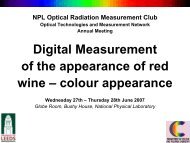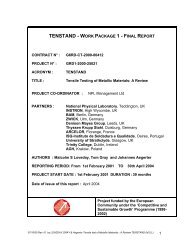CALIBRATION OF AC-DC CURRENT TRANSFER STANDARDS ...
CALIBRATION OF AC-DC CURRENT TRANSFER STANDARDS ...
CALIBRATION OF AC-DC CURRENT TRANSFER STANDARDS ...
Create successful ePaper yourself
Turn your PDF publications into a flip-book with our unique Google optimized e-Paper software.
<strong>CALIBRATION</strong> <strong>OF</strong><br />
<strong>AC</strong>-<strong>DC</strong> <strong>CURRENT</strong> <strong>TRANSFER</strong> <strong>STANDARDS</strong><br />
BASED ON<br />
CALCUABLE THERMAL CONVERTERS ON<br />
QUARTZ SUBSTRATE<br />
Torsten Funck<br />
P TB<br />
B
Contents<br />
• Introduction<br />
• Quartz-PMJTCs for current transfer<br />
• Calculation of the current transfer difference<br />
• Validation of the model used for calculation<br />
• Measurement setup<br />
• <strong>AC</strong>-<strong>DC</strong> current transfer standards<br />
• Step-up chains<br />
• Improved measurement uncertainties<br />
• Conclusions<br />
EM Day 2007 <strong>AC</strong>-<strong>DC</strong> <strong>AC</strong> <strong>DC</strong> current transfer standards<br />
2<br />
P TB<br />
B
Introduction<br />
Electrical quantities are defined, realized an maintained at direct<br />
current (dc).<br />
EM Day 2007 <strong>AC</strong>-<strong>DC</strong> <strong>AC</strong> <strong>DC</strong> current transfer standards<br />
3<br />
P TB<br />
B<br />
For alternating current (ac) calibrations, traceability is given due to<br />
ac-dc transfer.<br />
For current, the measured quantity is δ i , the ac-dc current transfer<br />
difference:<br />
I<br />
δ=<br />
i<br />
ac<br />
−I<br />
I<br />
dc<br />
dc
Quartz-PMJTCs<br />
EM Day 2007 <strong>AC</strong>-<strong>DC</strong> <strong>AC</strong> <strong>DC</strong> current transfer standards<br />
4<br />
P TB<br />
B<br />
Planar multijunction thermal converters (PMJTCs) on a quartz<br />
substrate are used as a calcuable standard<br />
+ Very low conductivity of the substrate<br />
+ Low dielectric constant ε r<br />
+ Low, calculable transfer difference<br />
- Difficult to manufacture<br />
- Low thermal time-constant<br />
- Low sensitivity
Calculation of δ i due to heater impedance<br />
L H /10<br />
L H /10<br />
R<br />
Re<br />
EM Day 2007 <strong>AC</strong>-<strong>DC</strong> <strong>AC</strong> <strong>DC</strong> current transfer standards<br />
δ<br />
R H /10<br />
R H /10<br />
i1<br />
=<br />
0<br />
C 2 /10<br />
0<br />
C 1 /10<br />
C 2 /10<br />
{ } 1 H −<br />
Z<br />
0<br />
0<br />
G 2 vs (f)<br />
G 1 vs (f)<br />
G 2 vs (f)<br />
5<br />
P TB<br />
B
Calculation of δ i due to stray capacitances<br />
R Cu<br />
I I<br />
f, 0<br />
R Cu<br />
L Cu<br />
L Cu<br />
C carrier<br />
δ<br />
i2<br />
=<br />
R Au<br />
R Au<br />
EM Day 2007 <strong>AC</strong>-<strong>DC</strong> <strong>AC</strong> <strong>DC</strong> current transfer standards<br />
L Au<br />
G carrier<br />
L Au<br />
C wAu<br />
| |<br />
| | 1<br />
Z2⋅(<br />
Z3+<br />
Z4<br />
)<br />
−<br />
Z ⋅(<br />
⋅Z+<br />
Z )<br />
3<br />
2 1 2<br />
L H<br />
G quartz<br />
L H<br />
R H<br />
6<br />
P TB<br />
B
Current transfer differences<br />
30<br />
μ A/A<br />
25<br />
δ i<br />
20<br />
15<br />
10<br />
5<br />
0<br />
-5<br />
R H = 700 Ω<br />
R H = 350 Ω<br />
R H = 240 Ω<br />
R H = 117 Ω<br />
0,1 MHz 1<br />
frequency<br />
EM Day 2007 <strong>AC</strong>-<strong>DC</strong> <strong>AC</strong> <strong>DC</strong> current transfer standards<br />
7<br />
P TB<br />
B
Validation of the calculation<br />
μA/A<br />
Δδ i<br />
2<br />
0<br />
-2<br />
-4<br />
-6<br />
-8<br />
-10<br />
-12<br />
-14<br />
-16<br />
117 Ω - 700 Ω<br />
measured<br />
calculated<br />
0,1 MHz 1<br />
frequency<br />
EM Day 2007 <strong>AC</strong>-<strong>DC</strong> <strong>AC</strong> <strong>DC</strong> current transfer standards<br />
8<br />
P TB<br />
B
Uncertainties using built-in Tee<br />
μA/A<br />
0,6<br />
u<br />
0,7<br />
0,5<br />
0,4<br />
0,3<br />
0,2<br />
0,1<br />
frequency<br />
MHz 1<br />
EM Day 2007 <strong>AC</strong>-<strong>DC</strong> <strong>AC</strong> <strong>DC</strong> current transfer standards<br />
9<br />
P TB<br />
B
Measurement setup using driven guards<br />
• Symmetrical setup<br />
• Upper standard connected „upside down“<br />
• Constant voltage across parasitic capacitances =><br />
equal transfer differences in “upper position” and<br />
“lower position”<br />
EM Day 2007 <strong>AC</strong>-<strong>DC</strong> <strong>AC</strong> <strong>DC</strong> current transfer standards<br />
10<br />
P TB<br />
B
<strong>AC</strong>-<strong>DC</strong> current transfer standards<br />
• Low currents: PMJTC with low heater<br />
resistance<br />
EM Day 2007 <strong>AC</strong>-<strong>DC</strong> <strong>AC</strong> <strong>DC</strong> current transfer standards<br />
11<br />
P TB<br />
B<br />
Problem: Technology limits 90 Ω < R H < 900 Ω<br />
• Medium currents: Shunt + PMJTC<br />
Problems: Shunt inductance<br />
Current dependence<br />
• High currents: Cooled shunt + PMJTC<br />
Problems: Shunt inductance<br />
Current dependence<br />
Compliance voltage of current source
Shunts used at PTB<br />
Up to 300 mA: PTB design (top)<br />
500 mA to 5 A: Holt design (middle)<br />
10 A and 20 A: Fluke design (bottom)<br />
EM Day 2007 <strong>AC</strong>-<strong>DC</strong> <strong>AC</strong> <strong>DC</strong> current transfer standards<br />
12<br />
P TB<br />
B
Shunts in Justervesenet design<br />
Current<br />
input<br />
+ Low cost materials<br />
Resistors<br />
Output to<br />
TCC<br />
+ Large number of resistors ensure equal<br />
current distribution<br />
+ Very small area of current path yields low<br />
inductive coupling<br />
- No case<br />
EM Day 2007 <strong>AC</strong>-<strong>DC</strong> <strong>AC</strong> <strong>DC</strong> current transfer standards<br />
13<br />
P TB<br />
B<br />
Justervesenet
High current shunts<br />
Set of four shunts:<br />
• 10 A to 30 A (25 mΩ)<br />
• 30 A to 50 A (10 mΩ)<br />
• 50 A to 80 A (5 mΩ)<br />
• 80 A to 100 A (3 mΩ)<br />
EM Day 2007 <strong>AC</strong>-<strong>DC</strong> <strong>AC</strong> <strong>DC</strong> current transfer standards<br />
EL-9800<br />
(NIST Design)<br />
14<br />
P TB<br />
B
New high current shunts<br />
Proven design scaled for<br />
higher currents<br />
800 mV nominal output<br />
voltage<br />
Available up to 100 A<br />
+ Precision resistors provide also dc accuracy<br />
+ Large number of resistors ensure equal current distribution<br />
+ Small area of current path yields low inductive coupling<br />
- No case<br />
- Quite expensive<br />
EM Day 2007 <strong>AC</strong>-<strong>DC</strong> <strong>AC</strong> <strong>DC</strong> current transfer standards<br />
15<br />
P TB<br />
B
Step-up chains using different standards<br />
Step \ Chain<br />
start<br />
1<br />
2<br />
3<br />
4<br />
5<br />
6<br />
7<br />
1 A<br />
2 A<br />
5 A<br />
20 mA<br />
50 mA<br />
100 mA<br />
200 mA<br />
500 mA<br />
EM Day 2007 <strong>AC</strong>-<strong>DC</strong> <strong>AC</strong> <strong>DC</strong> current transfer standards<br />
1 A<br />
5 A<br />
100 mA<br />
500 mA<br />
Chains A & B: Self-made and Holt shunts<br />
A<br />
30 mA<br />
Chain C: Justervesenet-Shunts (two sets)<br />
B<br />
C<br />
1 A<br />
3 A<br />
5 A<br />
30 mA<br />
100 mA<br />
300 mA<br />
Comparison of the chains: 1 A at 1 MHz: Δ < 10 µA/A<br />
5 A at 100 kHz: Δ < 5 µA/A<br />
16<br />
P TB<br />
B
Measurement of the level dependence<br />
Assumption:<br />
Current level dependence of shunts<br />
results from self-heating<br />
Measurement approach:<br />
Shunt with low voltage drop used as a standard<br />
EM Day 2007 <strong>AC</strong>-<strong>DC</strong> <strong>AC</strong> <strong>DC</strong> current transfer standards<br />
17<br />
P TB<br />
B<br />
• => Low power => low self-heating => low current level dependence<br />
• Low voltage drop => voltage-amplifier necessary to operate PMJTC
Measurement setup: Shunt with Amplifier<br />
Device<br />
under test<br />
<strong>AC</strong><br />
Voltage<br />
Transconductance<br />
Amplifier<br />
PMJTC<br />
<strong>AC</strong>-<strong>DC</strong> Switch<br />
EM Day 2007 <strong>AC</strong>-<strong>DC</strong> <strong>AC</strong> <strong>DC</strong> current transfer standards<br />
Hi<br />
Low<br />
Shunt<br />
Shunt<br />
x11<br />
<strong>DC</strong><br />
Voltage<br />
Amplifier<br />
with PMJTC<br />
nV nV<br />
Hi<br />
Low<br />
Standard<br />
18<br />
P TB<br />
B
Uncertainty of measurement<br />
The following sources of uncertainty of the step-up<br />
procedure can be identified for each step:<br />
u (δ std ) Standard uncertainty of the (calculable) transfer difference of<br />
the standard used, i.e. uncertainty of previous step<br />
u (δ C ) Standard uncertainty of the comparison procedure<br />
EM Day 2007 <strong>AC</strong>-<strong>DC</strong> <strong>AC</strong> <strong>DC</strong> current transfer standards<br />
19<br />
P TB<br />
B<br />
u (δ A ) Type A standard uncertainty, i.e. the standard deviation of the<br />
mean<br />
u (δ Lev ) Standard uncertainty due to the current level effects<br />
in the shunt<br />
u (δ LF ) Standard uncertainty due to PMJTC low frequency<br />
effects, which are level dependent
Improvements in measurement uncertainties<br />
Current<br />
30 mA<br />
100 mA<br />
300 mA<br />
1 A<br />
3 A<br />
10 A<br />
30 A<br />
100 A<br />
Expanded uncertainty of measurement in µA/A at the frequencies<br />
EM Day 2007 <strong>AC</strong>-<strong>DC</strong> <strong>AC</strong> <strong>DC</strong> current transfer standards<br />
20<br />
P TB<br />
B<br />
10 Hz 1 kHz 10 kHz 100 kHz 500 kHz 1 MHz<br />
5 5 5 10 - -<br />
1 1 1 1 1 2<br />
5 5 5 10 - -<br />
2 2 2 2 2 5<br />
10 10 10 20 - -<br />
2 2 2 2 3 5<br />
10 10 10 30 - -<br />
4 3 3 4 6 10<br />
20 20 20 60<br />
4 4 4 8<br />
25 25 25 80<br />
12 12 12 25<br />
-<br />
30<br />
-<br />
30<br />
-<br />
60<br />
-<br />
120<br />
Blue: (2006)<br />
- - - -<br />
40 40 80 150<br />
Red : old (2002)
Conclusions<br />
• PMJTCs on quartz substrate developed at PTB are well suited<br />
for current transfer at low current up to 1 MHz<br />
• Potential driven guarding reduces the uncertainty of the<br />
comparison measurements<br />
• New shunts with low current level dependence and low<br />
transfer difference allow further reduction of the step-up<br />
procedure's uncertainty<br />
• New approaches for the determination of the current level<br />
dependence allow for corrections and therefore for further<br />
reduction of the uncertainty<br />
EM Day 2007 <strong>AC</strong>-<strong>DC</strong> <strong>AC</strong> <strong>DC</strong> current transfer standards<br />
21<br />
P TB<br />
B
Thank you for your<br />
EM Day 2007 <strong>AC</strong>-<strong>DC</strong> <strong>AC</strong> <strong>DC</strong> current transfer standards<br />
attention!<br />
Torsten Funck<br />
22<br />
P TB<br />
B








